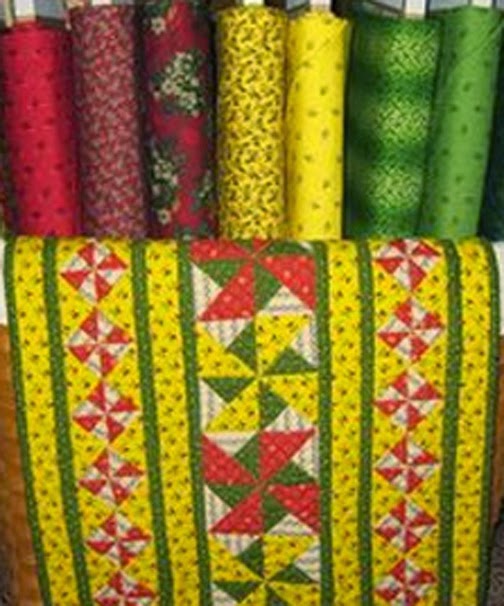Reproduction star block by Becky Brown
Reproduction star block by Becky Brown
Vintage block, mid 19th century
Here's a copy of that block that I made. I even had the same chrome yellow print in a reproduction.
Vintage applique, mid-19th-century
That must have been one popular print.
Vintage quilt 1880-1910 detail
Vintage top 1830-1860
You can find the color in early 19th century quilts. The mineral dye process dates back to the 1810s.
The chemistry for chrome orange and chrome yellow
is quite similar. Above, a New York quilt dated
1859-60 includes both colors.
Vintage quilt 1840-1870
Vintage quilt 1840-1870
Chrome yellow became quite popular with quilters about 1840, when the colors of German folkloric arts were adopted for quilts.
Vintage quilt 1870-1910
The shade continued popular through the end of the 19th century.
Vintage quilt 1870-1900
Vintage top 1890-1920
A swatch from William Crooke’s 1882 manual on prints and dyes showing
chrome or canary yellow stripes.
Vintage chrome yellow prints
Chrome yellow prints---often the same print over and over--- became known as oil-boiled calicoes after 1880 or so. (Oil-boiled refers to an obsolete step in the printing process.)
We might consider these 1880-1930 prints
a reproduction of the 1840-1880 style.
Quilters in southeastern Pennsylvania bought many yards.
Block by Carrie Hall, probably made about 1930, in Spencer Museum of Art collection.
Hall used nostalgic reproduction prints to get the traditional color scheme.
Ann Hermes has this end-of-the-19th century
quilt for sale in her Etsy shop.
Reproductions
Reproduction block by Becky Brown in
chrome orange plain and chrome yellow print
A reproduction of a reproduction from my collection
Old Fashioned Calicoes
Dawn Cook Ronigan's reproduction
miniquilt, donated to the AQSG auction last year.
She emphasized bright chrome yellows and chrome oranges in her reproduction palette.
Reader Valerie's green and red blocks backed by reproduction
prints from her chrome yellow stash.
S.F. used chrome orange and chrome yellow.
Reproduction chrome yellows
Judie Rothermel from Party of 12
Chrome yellows don't sell as well as reproduction blues and madder browns so good repros are sometimes hard to find. You need a collection of prints and solids in your stash.
Recent line: Touch of Baltimore from Little Quilts.
Display at the Thistle Bee Quilt Shoppe.
Reproduction Star by Bettina Havig
You see a lot of chrome yellow solids in antique applique.
Vintage applique quilt dated 1858
Moda's Bella Solid 9900-131, Lemon, is a good match
if you are looking for a canary solid.
What to do with Your Stack of Star Blocks
More Ideas for Alternate Applique
Buy these patterns. Adapt them for 6" blocks.
Here's an excellent idea for alternate applique from
friends Alma Allen, Jan Patek and Sue Spargo who
included "Cottage Flower" in their 2000 book Simple Pleasures
A Cottage Flower block by Karen at Log Cabin Quilts,
who did a lovely job with classic prints pushed to low values.
Froncie Quinn at Hoopla reproduced a
quilt by Florence Peto from the 1940s in which
simple applique alternates with nine-patches.
Why not stars instead of nine-patches?
See the Calico Garden here:
Peto's original used some Chrome Yellow reproduction
prints.
Lisa Bongean at Primitive Gatherings designed her own version of Peto's quilt:
Lisa's Flower Garden
with her ideas for simple applique and color.
Lisa's Flower Garden
One More Thing About Chrome Yellow
Chrome yellow cottons were produced in England but mainly for export. Chrome dyed fabrics, especially the solids and the brightest prints, seem to have been sold in the United States primarily for quilts.
In her research for the Ohio Quilt Project, fashion historian Virginia Gunn found an 1849 advertisement for dressmaking drygoods, such as printed lawns and ginghams, with a separate category: “Green and Yellow Prints for Quilts.” Yellow and gold solids are not found in American clothing---gowns, shirts or baby outfits. Gunn wrote that any “solid-colored cotton was little used as dress fabric.”
In 1842 a Baton Rouge merchant offered
"French, English and American calicos, a variety of patterns, red, blue and green,"
probably aiming at that same quilt customer.
Drygoods store in Minnesota, about 1900
See another post about chrome yellow here:














.jpg)























.jpg)



8 comments:
Oh Boy! My absolute favorite. I know part of this exercise is to "build up" your stash. Since I haven't "had" to go shopping yet (thanks to 20 plus years of monthly visits to my favorite quilt shop), I must get out there and do my part! Hope to see some of you "Time Warp" people in my travels. Maybe we should wear some kind of identification. The "Turkey red Badge of Courage"?
Look at Wendy who loves yellows quilt at this link:::
http://aquilterbynight.blogspot.com/2013/08/quilts-by-wendy-caton-reed-at-images.html
Love to use chrome yellow and have much in my stash!
Another informative post. I have no chrome yellow whatsoever! Sure hope my LQS has some available;).
I have never been one to use yellows in my quilts, I usually go with darker shades or gold. I think with the right colors and design, it makes for a stunning contrast.
Debbie
I had a little yellow but happily bought some more today. Really enjoying this series, so much to learn.
Yay yellow! Why yes, I did have **some** in my stash.
And I'm enjoying being inspired by all the suggestions for using our stars!
Jeanne :)
I needed to shopping for more Chrome Yellows. The fabric shop I went to never heard the term before, and the represent Civil War reproduction fabrics. I did find a couple while I shopped.
Great information once again!
Post a Comment